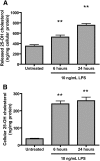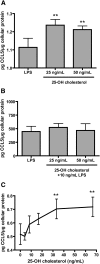Marked upregulation of cholesterol 25-hydroxylase expression by lipopolysaccharide
- PMID: 19502589
- PMCID: PMC2759831
- DOI: 10.1194/jlr.M900107-JLR200
Marked upregulation of cholesterol 25-hydroxylase expression by lipopolysaccharide
Abstract
During screening of genes upregulated by lipopolysaccharide (LPS; endotoxin) treatment of bone marrow-derived mouse macrophages, it was unexpectedly found that cholesterol 25-hydroxylase (Ch25h) was strongly upregulated. Treatment of macrophages with 10 ng/ml of LPS for 2 h resulted in a 35-fold increase in the expression of Ch25h. In contrast, LPS treatment did not increase the expression of Cyp27a1 or Cyp7b1. The increased Ch25h expression was found to be independent of Myeloid differentiation protein 88 signaling but dependent on Toll-like receptor 4 signaling. LPS treatment of macrophages caused a 6- to 7-fold increase in cellular 25-hydroxycholesterol concentration. When macrophages were treated with increasing concentrations of 25-hydroxycholesterol, a dose-dependent release of CCL5 into the culture medium was observed. Intravenous injection of LPS in eight healthy volunteers resulted in an increase in plasma 25-hydroxycholesterol concentration. The possibility is discussed that 25-hydroxycholesterol may have a role in the inflammatory response, in addition to its more established role in the regulation of cholesterol homeostasis.
Figures





References
-
- Fieser L. F., Huang W-Y., Bhattacharyya B. K. 1957. Cholesterol and companions. X. The diol fraction. J. Org. Chem. 22: 1380–1384.
-
- van Lier J. E., Smith L. L. 1967. Sterol metabolism. I. 26-Hydroxycholesterol in the human aorta. Biochemistry. 6: 3269–3278. - PubMed
-
- Björkhem I., Gustafsson J. 1974. Mitochondrial ω-hydroxylation of cholesterol side chain. J. Biol. Chem. 249: 2528–2535. - PubMed
-
- Lund E., Björkhem I., Furster C., Wikvall K. 1993. 24-, 25- and 27-hydroxylation of cholesterol by a purified preparation of 27-hydroxylase from pig liver. Biochim. Biophys. Acta. 1166: 177–182. - PubMed
-
- Li X., Pandak W. M., Erickson S. K., Ma Y., Yin L., Hylemon P., Ren S. 2007. Biosynthesis of the regulatory oxysterol, 5-cholesten-3beta,25-diol 3-sulfate, in hepatocytes. J. Lipid Res. 48: 2587–2596. - PubMed
Publication types
MeSH terms
Substances
LinkOut - more resources
Full Text Sources
Other Literature Sources
Molecular Biology Databases

